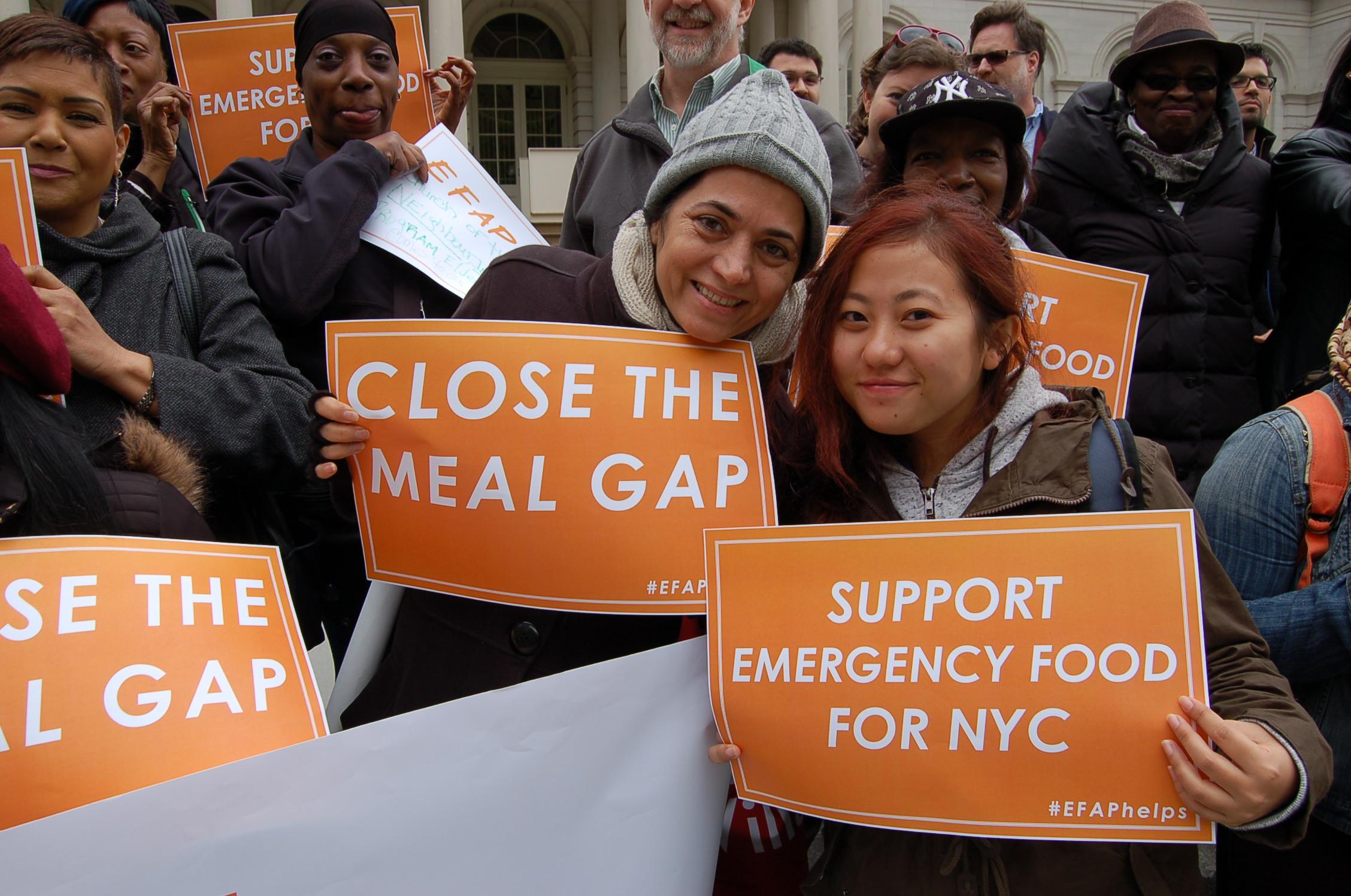Part of the Food Policy Community Spotlight Series
Name: Food Bank for New York City
What they do: Food Bank For New York City has been working to end food poverty in the five boroughs of New York City for 35 years. New York City’s food insecurity rate is 12 percent higher than the national rate, and 21 percent higher than the rate for New York State as a whole. As the city’s largest hunger-relief organization, Food Bank uses a multifaceted approach to helping low-income New Yorkers overcome their circumstances and achieve greater independence. Through its network of more than 1,000 charities and schools citywide, their food distribution program provides approximately 58 million free meals per year for New Yorkers in need. Along with fighting hunger by providing meals, Food Bank also provides other services, including free tax preparation and SNAP enrollment assistance to help raise the poorest New Yorkers out of poverty—hunger’s root cause. Through these vital services, they have put more than $115 million a year into the pockets of low-income New Yorkers, helping them afford food. In addition, Food Bank’s nutrition education programs and services empower more than 50,000 children, teens and adults to sustain a healthy diet on a limited budget. Working toward long-term solutions to food poverty, the organization also develops policy and conducts research to inform community and government efforts.
How they do it: Food Bank for New York City takes a strategic, multifaceted approach that provides meals and builds capacity in the neediest communities, while raising awareness and engagement among all New Yorkers. Food Bank utilizes multiple strategies to solve the problem of food insecurity and hunger including: (1) The Meal Gap Strategy, which determines where hunger is most concentrated city-wide so that areas in need can be accurately identified and action can be taken; (2) Food Distribution, through which they collect and store food in their 90,000 square-foot warehouse for efficient distribution to more than 1,000 charities citywide. Specifically, Food Bank’s Green Sidewalk program works to meet the need for fresh produce in high Meal Gap areas by delivering fruits and vegetables via “pop-ups”– Food Bank trucks that set up distribution events on sidewalks in front of local partner organizations; (3) Income Support, through which they provide free SNAP assistance and tax preparation services to low income New Yorkers; (4) Advocacy, through which, with the help of its citywide network, Food Bank develops hunger-relief policy and conducts research to inform community and government efforts; (5) Capacity Building, which offers training and technical assistance on SNAP outreach to hundreds of charities citywide so that they can act as SNAP resource centers; (6) Nutrition Education to empower youths and adults to sustain a healthy diet on a budget and adopt a healthy lifestyle.
Food Bank delivers Nutrition Education in 3 distinct ways:
1. CookShop in Schools: With the understanding that a student’s success is affected by whether or not he or she is hungry, Food Bank offers a curriculum and resources to NYC public schools via its Cookshop Program, which teaches nutrition and provides physical activity information as well as cooking skills, fostering enthusiasm for fresh, affordable fruits, vegetables and other whole foods.
- CookShop Classroom works with students in more than 2.200 public elementary schools and after school classes throughout the five boroughs to explore cooking and physical activities that foster their enjoyment and consumption of healthy food, as well as their appreciation for good nutrition and living an active lifestyle. CookShop for Families is a complementary program for parents and guardians of children in schools that participate in CookShop Classroom whose goal is to engage whole families in making healthy choices. Participants complete workshops focusing on such topics as reading food labels, meal planning, portion size and physical activity.
2. CookShop in Communities: Food Bank’s Community CookShop is an interactive intergenerational nutrition-education program that offers hands-on experience to equip participants with the knowledge and cooking skills to make nutritious food choices on a limited budget. The program was originally developed for organizations providing emergency food relief services, such as soup kitchens and food pantries throughout New York City. It has since been adapted for used in soup kitchens, food pantries, schools, after-school programs and housing facilities across the country. Sites need only apply to receive the Community CookShop curriculum.
3. EATWISE Program: Food Bank’s EATWISE (Educated and Aware Teens Who Inspire Smart Eating) is a free nutrition education program developed with teens for teens, empowering them to make smart food choices, promoting healthy dietary habits and providing opportunities for leadership within the community.
Mission: To end hunger by providing food, information and support for community survival, empowerment, and dignity
Latest project/campaign: In 2017, hundreds of Food Bank staff and volunteers gathered at Bright Temple Church in Hunts Point, Bronx, an area that has one of the highest meal gaps in the city, to create the community’s first and only soup kitchen. Opening this soup kitchen is part of Food Bank’s ongoing commitment to meet need wherever it is across the five boroughs.
Major Funding: Public and privately funded
Profit/nonprofit: Nonprofit
Annual Budget: $115.6 million
Interesting fact about how it is working to positively affect the food system: Food Bank For New York City has partnerships with 23 farms, primarily in New York State, to provide nearly 20 million pounds of produce to New Yorkers in need.
FACT SHEET:
Location:
39 Broadway, 10th Floor
New York City, NY 10006
Core Programs:
-Nutrition Education: CookShop Classroom, CookShop for Families, Community CookShop
-Food Distribution: Green Sidewalk
-Income Support and SNAP services
-Advocacy
Number of staff: 150
Number of volunteers: 800
Areas served: Bronx, Brooklyn, Manhattan, Staten Island, Queens
Year Started: 1983
Executive Director: Margarette Purvis
Contact Information: Contact Form


